Sulfur dioxide absorbent is an ionic liquid including a salt of a diamine compound that is substituted with a hydroxyl group
Lee , et al. February 23, 2
U.S. patent number 10,926,213 [Application Number 16/454,566] was granted by the patent office on 2021-02-23 for sulfur dioxide absorbent is an ionic liquid including a salt of a diamine compound that is substituted with a hydroxyl group. This patent grant is currently assigned to Korea Institute of Science and Technology. The grantee listed for this patent is KOREA INSTITUTE OF SCIENCE AND TECHNOLOGY. Invention is credited to Shinhye Cho, Hong Gon Kim, He Won Lee, Hyun Joo Lee, Ung Lee.



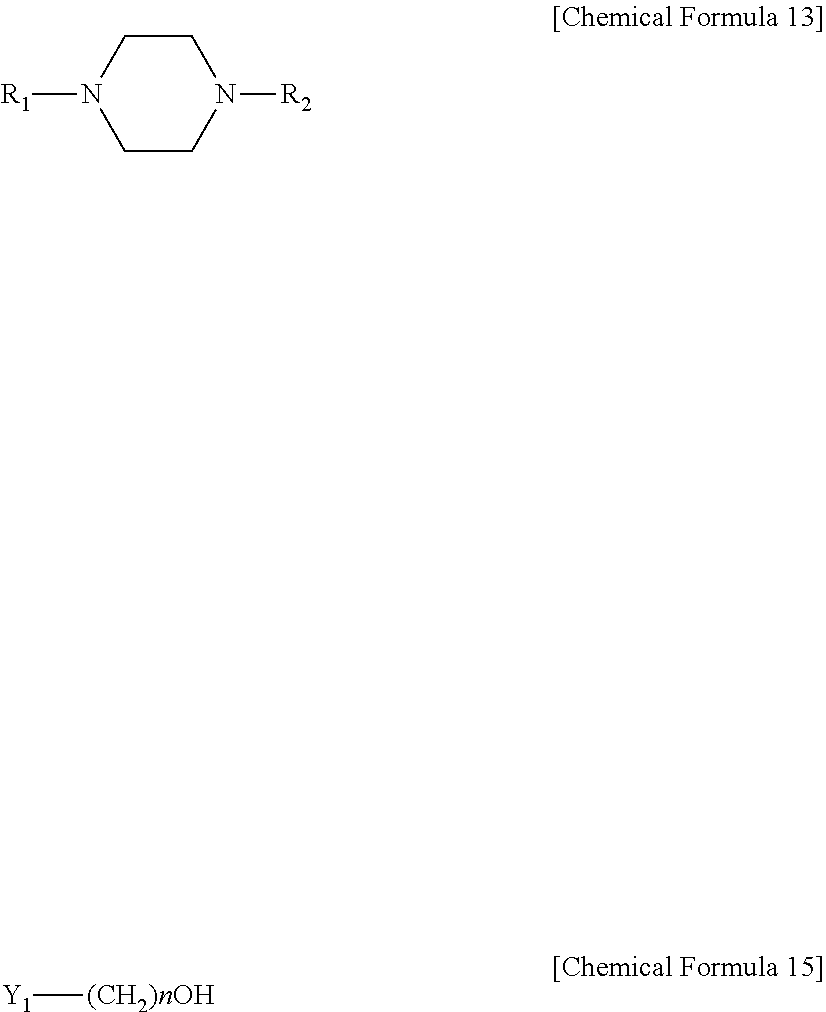
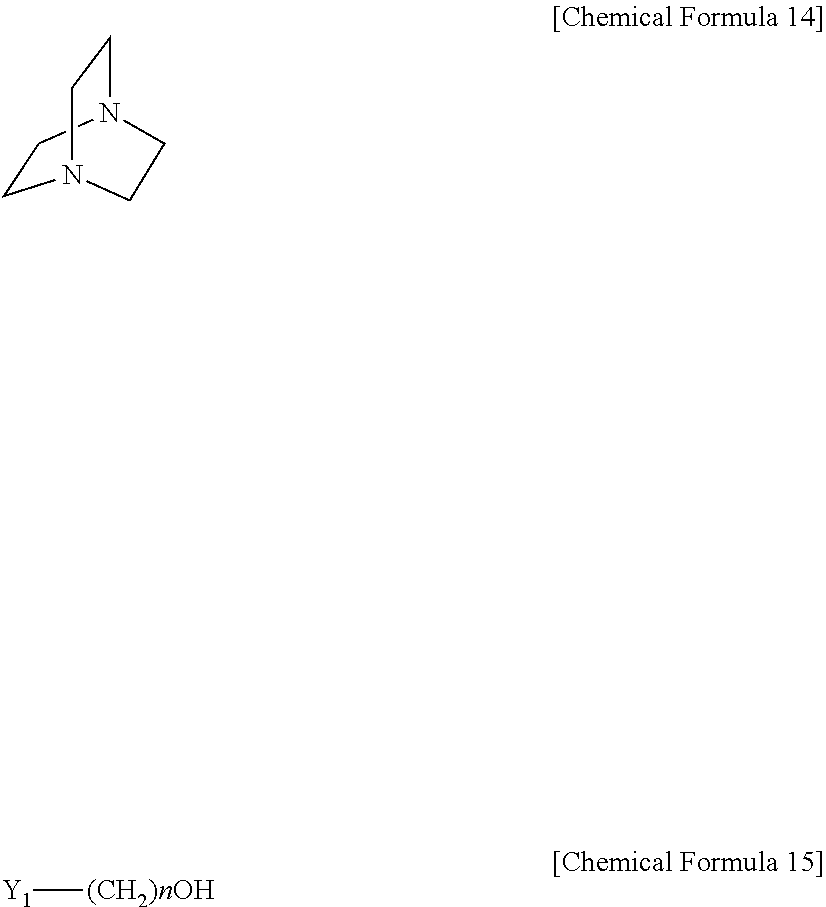
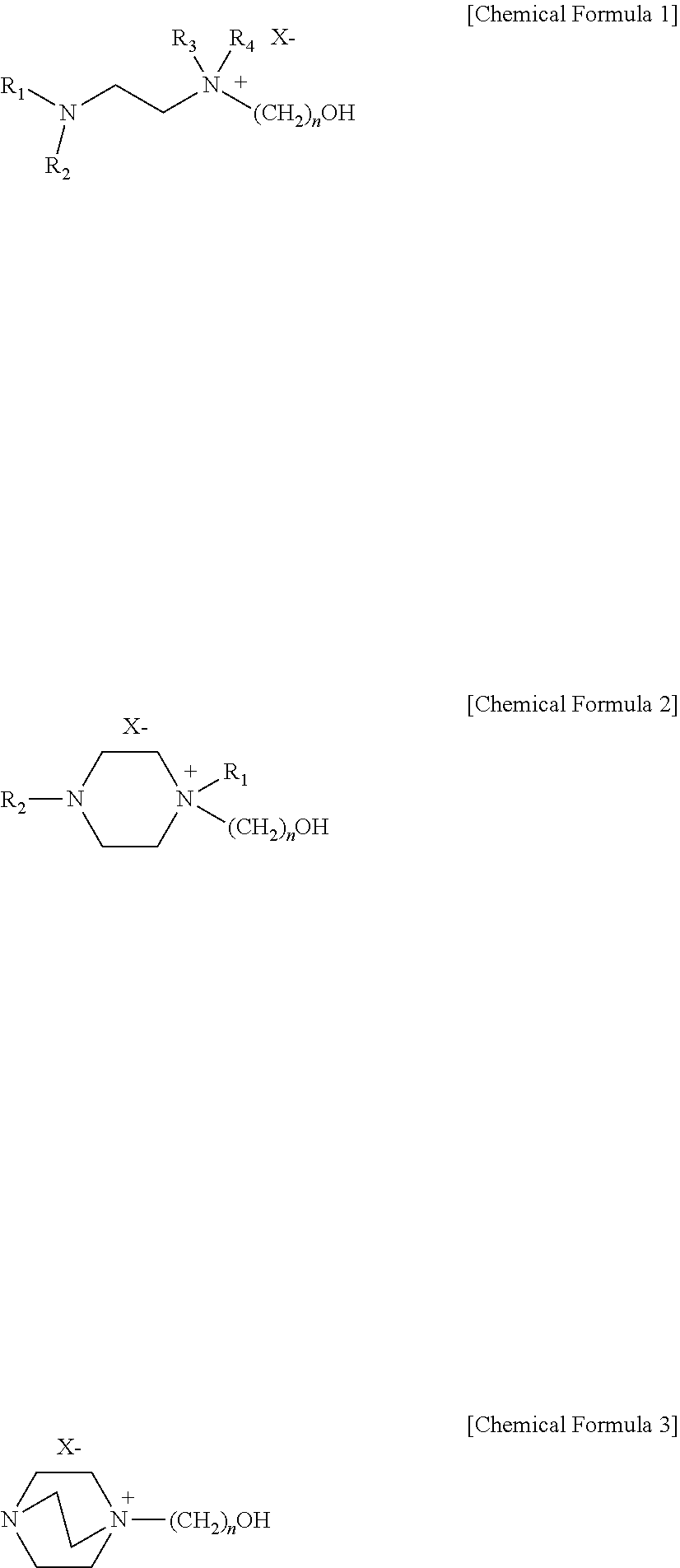

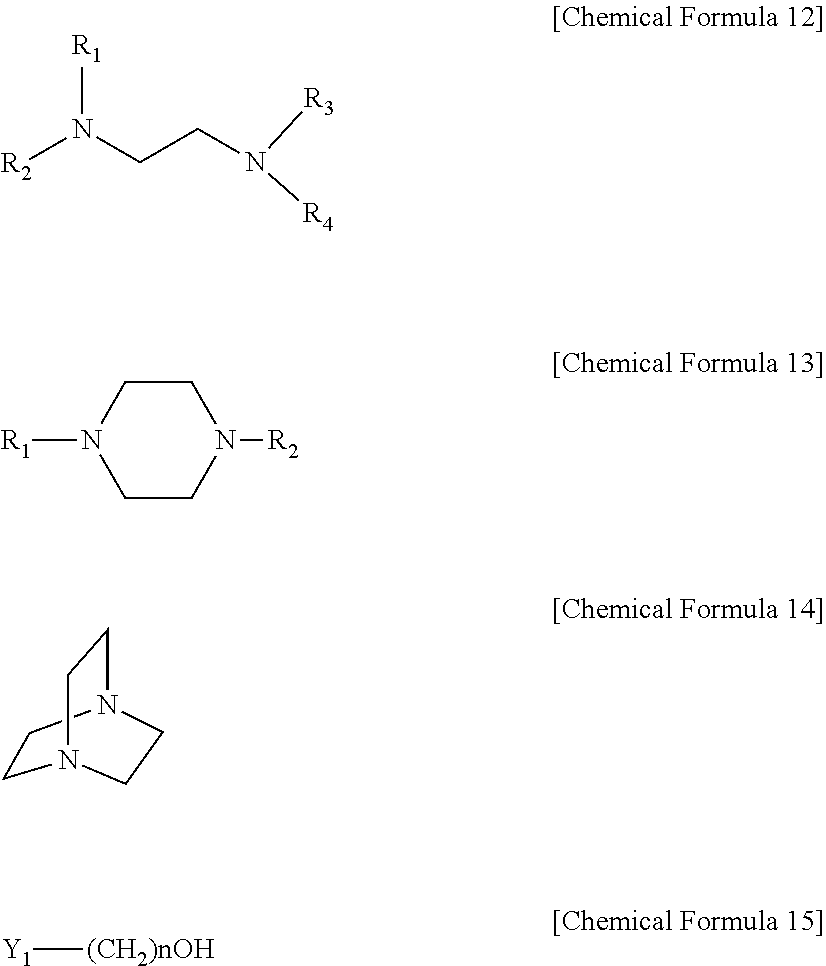



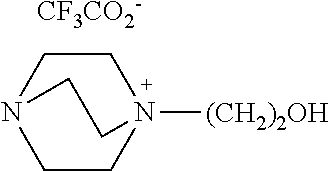
View All Diagrams
| United States Patent | 10,926,213 |
| Lee , et al. | February 23, 2021 |
Sulfur dioxide absorbent is an ionic liquid including a salt of a diamine compound that is substituted with a hydroxyl group
Abstract
A sulfur dioxide absorbent that is an ionic liquid including a solvent; and a salt of a diamine compound that is substituted with a hydroxyl group and has a chemical formula 1 to 3 below dissolved in the solvent: ##STR00001## where, in Chemical Formula 1 and 2, R.sub.1-R.sub.4 are the same or different and each is independently selected from the group consisting of H, a C1-C6 alkyl, and a C1-C6 alkoxy; and where, in Chemical Formula 1 to 3, X is selected from the group consisting of Cl, Br, I, MeSO.sub.3, CF.sub.3SO.sub.3, HCO.sub.2, CF.sub.3CO.sub.2 and CH.sub.3CO.sub.2; and n is an integer of 1-10. The sulfur dioxide absorbent is constituted to selectively absorb sulfur dioxide and sulfurous acid (H.sub.2SO.sub.3) formed by combination of sulfur dioxide with water, not CO.sub.2.
| Inventors: | Lee; Hyun Joo (Seoul, KR), Lee; Ung (Seoul, KR), Kim; Hong Gon (Seoul, KR), Cho; Shinhye (Seoul, KR), Lee; He Won (Seoul, KR) | ||||||||||
|---|---|---|---|---|---|---|---|---|---|---|---|
| Applicant: |
|
||||||||||
| Assignee: | Korea Institute of Science and
Technology (Seoul, KR) |
||||||||||
| Family ID: | 1000005375450 | ||||||||||
| Appl. No.: | 16/454,566 | ||||||||||
| Filed: | June 27, 2019 |
Prior Publication Data
| Document Identifier | Publication Date | |
|---|---|---|
| US 20200155997 A1 | May 21, 2020 | |
Foreign Application Priority Data
| Nov 20, 2018 [KR] | 10-2018-0143845 | |||
| Current U.S. Class: | 1/1 |
| Current CPC Class: | C07C 215/40 (20130101); B01D 53/78 (20130101); C07D 241/04 (20130101); B01D 53/507 (20130101); C07D 487/08 (20130101); B01D 53/1481 (20130101); B01D 53/1493 (20130101); B01D 2252/20447 (20130101); B01D 2252/20431 (20130101); B01D 2252/2041 (20130101); B01D 2252/30 (20130101); B01D 2252/20484 (20130101) |
| Current International Class: | C07D 487/08 (20060101); B01D 53/50 (20060101); B01D 53/78 (20060101); C07C 215/40 (20060101); C07D 241/04 (20060101); B01D 53/14 (20060101) |
References Cited [Referenced By]
U.S. Patent Documents
| 2404854 | December 1944 | Latchum, Jr. et al. |
| 3904735 | September 1975 | Atwood et al. |
| 4201752 | May 1980 | Kosseim et al. |
| 6623659 | September 2003 | Munson et al. |
| 6849774 | February 2005 | Boudreau et al. |
| 2008/0146849 | June 2008 | Dai et al. |
| 2008/0271381 | November 2008 | Harashina |
| 10-0831093 | May 2008 | KR | |||
| 10-2010-0043796 | Apr 2010 | KR | |||
| 10-1415844 | Jul 2014 | KR | |||
| 10-1415865 | Jul 2014 | KR | |||
Other References
|
PubChem CID 57294404 (2012). cited by examiner . PubChem CID 12293659 (2007). cited by examiner . PubChem CID 53705908 (2011). cited by examiner . Weize Wu et al., "Desulfurization of Flue Gas: SO.sub.2 Absorption by an Ionic Liquid", Angew. Chem. Int. Ed., 2004, pp. 2415-2417, vol. 43. cited by applicant . Sung Yun Hong et al., "Ether-functionalized ionic liquids as highly efficient SO.sub.2 absorbents", Energy & Environmental Science, 2011, pp. 1802-1806, vol. 4. cited by applicant . Guokai Cui et al., "Highly efficient SO.sub.2 capture by dual functionalized ionic liquids through a combination of chemical and physical absorption", Chem. Commun., 2012, pp. 2633-2635, vol. 48. cited by applicant . Luke J. Murphy et al., "Ionic liquids and acid gas capture: water and oxygen as confounding factors", Chem. Commun., 2012, pp. 1227-1229, vol. 48. cited by applicant. |
Primary Examiner: Rao; Deepak R
Attorney, Agent or Firm: Rabin & Berdo, P.C.
Claims
What is claimed is:
1. A sulfur dioxide absorbent that is an ionic liquid which absorbs sulfur dioxide and sulfurous acid (H.sub.2SO.sub.3), comprising: a solvent; and a salt of a diamine compound that is substituted with a hydroxyl group, that has a chemical formula selected from the group consisting of Chemical Formula 1 to 3 below, and that is dissolved in the solvent: ##STR00017## where, in Chemical Formula 1 and 2, R.sub.1-R.sub.4 are the same or different and each is independently selected from the group consisting of H, a C1-C6 alkyl group, and a C1-C6 alkoxy group; and where, in Chemical Formula 1 to 3, X is selected from the group consisting of Cl, Br, I, MeSO.sub.3, CF.sub.3SO.sub.3, HCO.sub.2, CF.sub.3CO.sub.2 and CH.sub.3CO.sub.2; and n is an integer of 1-10.
2. The sulfur dioxide absorbent according to claim 1, wherein the sulfur dioxide absorbent selectively absorbs sulfur dioxide and sulfurous acid (H.sub.2SO.sub.3) formed by combination of sulfur dioxide with water but not CO.sub.2.
3. The sulfur dioxide absorbent according to claim 1, wherein the sulfur dioxide absorbent has an absorption temperature that ranges from 10-80.degree. C.
4. The sulfur dioxide absorbent according to claim 1, wherein the sulfur dioxide absorbent has a desorption temperature that ranges from 50-150.degree. C.
5. The sulfur dioxide absorbent according to claim 1, wherein the sulfur dioxide absorbent is selected from the group consisting of Chemical Formula 4 to 11 below: ##STR00018##
6. The sulfur dioxide absorbent according to claim 1, wherein the chemical formula is Chemical Formula 2.
7. The sulfur dioxide absorbent according to claim 1, wherein the chemical formula is Chemical Formula 2 and X is Cl, Br, or I.
8. A sulfur dioxide absorbent that is an ionic liquid which absorbs sulfur dioxide and sulfurous acid (H.sub.2SO.sub.3), comprising: a solvent; and a salt of a diamine compound that is substituted with a hydroxyl group, that has a chemical formula selected from the group consisting of Chemical Formula 1 to 3 below, and that is dissolved in the solvent: ##STR00019## where, in Chemical Formula 1 and 2, R.sub.1-R.sub.4 are the same or different and each is independently selected from the group consisting of H, a C1-C6 alkyl group, and a C1-C6 alkoxy group; and where, in Chemical Formula 1 to 3, X is selected from the group consisting of Cl, Br, I, CF.sub.3SO.sub.3, and CF.sub.3CO.sub.2; and n is an integer of 1-10.
9. The sulfur dioxide absorbent according to claim 8, wherein the sulfur dioxide absorbent is selected from the group consisting of Chemical Formula 4 to 7, 10, and 11 below: ##STR00020##
10. The sulfur dioxide absorbent according to claim 8, wherein the sulfur dioxide absorbent selectively absorbs sulfur dioxide and sulfurous acid (H.sub.2SO.sub.3) formed by combination of sulfur dioxide with water but not CO.sub.2.
11. The sulfur dioxide absorbent according to claim 8, wherein the sulfur dioxide absorbent has an absorption temperature that ranges from 10-80.degree. C.
12. The sulfur dioxide absorbent according to claim 8, wherein the sulfur dioxide absorbent has a desorption temperature that ranges from 50-150.degree. C.
13. The sulfur dioxide absorbent according to claim 8, wherein the chemical formula is Chemical Formula 2.
14. The sulfur dioxide absorbent according to claim 8, wherein the chemical formula is Chemical Formula 2 and X is Cl, Br, or I.
15. A sulfur dioxide absorbent that is an ionic liquid which absorbs sulfur dioxide and sulfurous acid (H.sub.2SO.sub.3), comprising: a solvent; and a salt of a diamine compound that is substituted with a hydroxyl group, that has Chemical Formula 2 below, and that is dissolved in the solvent: ##STR00021## where R.sub.1 and R.sub.2 are the same or different and each is independently selected from the group consisting of H, a C1-C6 alkyl group, and a C1-C6 alkoxy group, X is chlorine (Cl), and n is an integer of 1-10.
16. The sulfur dioxide absorbent according to claim 15, wherein the sulfur dioxide absorbent selectively absorbs sulfur dioxide and sulfurous acid (H.sub.2SO.sub.3) formed by combination of sulfur dioxide with water but not CO.sub.2.
17. The sulfur dioxide absorbent according to claim 15, wherein the sulfur dioxide absorbent has an absorption temperature that ranges from 10-80.degree. C.
18. The sulfur dioxide absorbent according to claim 15, wherein the sulfur dioxide absorbent has a desorption temperature that ranges from 50-150.degree. C.
Description
CROSS-REFERENCE TO RELATED APPLICATIONS
This application claims priority under 35 U.S.C. .sctn. 119 to Korean Patent Application No. 10-2018-0143845 filed on Nov. 20, 2018 in the Korean Intellectual Property Office, the disclosure of which is incorporated herein by reference in its entirety.
TECHNICAL FIELD
The present disclosure relates to an absorbent capable of removing not only sulfur dioxide (SO.sub.2) contained in combustion exhaust gas or in the air but also sulfurous acid (H.sub.2SO.sub.3) formed by combination of sulfur dioxide with water. Particularly, the absorbent uses an ionic liquid in the form of a salt including a diamine compound substituted with a hydroxyl group.
BACKGROUND
In fossil fuel, such as coal and petroleum, a significant amount of sulfur compounds is contained and such sulfur compounds are emitted in the form of sulfur dioxide (SO.sub.2) which causes acid rain during production of energy through burning of fuel. Therefore, in most power plants or industrial facilities where fossil fuel is burned, desulfurized exhaust gas is emitted into the air to prevent emission of a main cause of air pollution.
Use of lime (CaO) or limestone (CaCO.sub.3) is known as a method for desulfurization of exhaust gas from a power plant. Use of such calcium compounds is advisable in terms of cost efficiency. However, since such calcium compounds have a significantly low solubility to water of about 0.17% (CaO) and about 0.0013% (CaCO.sub.3), they are pulverized into very small particles and then formed into slurry in water so that they may react with SO.sub.2. Herein, reaction with SO.sub.2 is a solid-liquid reaction, and thus does not show a high reaction rate as compared to a liquid-liquid reaction. In addition, use of an excessive amount of water causes a problem related with waste water and such low solubility to water causes a serious problem of pipe blockage during the overall process.
As a liquid SO.sub.2 absorbent, an amine-based compound has been used most widely. Particular examples of such absorbents include triethanolamine disclosed in U.S. Pat. No. 3,904,735, monoethanolamine disclosed in U.S. Pat. No. 4,201,752, and diethanolamine disclosed in U.S. Pat. No. 2,404,854. The reason why such an amine absorbent is used as SO.sub.2 absorbent is that amine bound chemically with SO.sub.2 undergoes a cleavage of binding under heating, and thus SO.sub.2 may be desorbed and collected and the absorbent may be regenerated. However, the amine process has the following disadvantages: a high absorbent regeneration temperature caused by strong binding between amine and sulfur dioxide and irreversible decomposition of amine; degradation of performance of the absorbent and supplement of the absorbent; corrosion of an absorption system caused by the amine itself or decomposition products thereof; and contamination of regenerated gas with the vapor pressure of the amine absorbent.
Recently, in order to overcome such disadvantages of the conventional absorbent, there has been an attempt to use an ionic liquid, which shows no volatility, has high thermal and chemical stability and maintains a liquid phase at a low temperature of 100.degree. C., as an absorbent, as disclosed in U.S. Pat. Nos. 6,849,774, 6,623,659, and US Patent Publication No. 2008-0146849.
In addition, according to Angew. Chem., Int. Ed. (2004, 43, 2415-2417), use of 1,1,3,3-tetramethylguanidinium lactate ([TMG]L) provides an SO.sub.2 absorption ratio of 0.978 mol per mole of ionic liquid. According to Korean Patent No. 10-0831093, [BMIm]Cl provides an SO.sub.2 absorption ratio of 1.68 mol per mole of ionic liquid and [EMIm]EtSO.sub.4 provides a relatively low SO.sub.2 absorption ratio of 0.92 mol per mole of ionic liquid. Further, according to Korean Patent Publication No. 10-2010-0043796, it is reported that a fluorine-containing ionic liquid, [BhFplm]CF.sub.3CO.sub.2 (1-butyl-3-hexafluoropropyl imidazolium trifluoroacetate) has high stability against heat and sulfur dioxide and absorbs 0.48 mol of sulfur dioxide per mol of ionic liquid.
However, since an ionic liquid having a fluorine-containing anion, such as tetrafluoroborate (BF.sub.4), is decomposed easily by moisture to produce hydrofluoric acid (HF), the ionic liquid as an absorbent may be lost and has a difficulty in regeneration. When the anion is Cl.sup.-, the ionic liquid is present in the form of solid at room temperature. Thus, there is a problem in that it is required to maintain the absorption temperature to 50.degree. C. or higher.
Energy Environ. Sci., 4, 1802-1806 (2011) and Chem. Commun., 2633-2635 (2012) discloses a method for increasing absorption ratio of SO.sub.2 by using an ionic liquid having an ether functional group or ionic liquid having a tetrazole ion. It is reported that each ionic liquid can absorb SO.sub.2 up to 4 mol per mol at 1 bar.
The ionic liquids having such high SO.sub.2 absorption ratio are characterized in that a Lewis base site capable of interacting with SO.sub.2 having Lewis acid property is present in the molecule. Therefore, molecules having a large number of Lewis base sites per unit molecule show high SO.sub.2 absorption ratio.
Meanwhile, exhaust gas includes 5-15% of moisture in addition to SO.sub.2. The presence of moisture may be concentrated together with an SO.sub.2 absorbent during the treatment of SO.sub.2, wherein SO.sub.2 reacts with water so that it is converted into a strong acid, H.sub.2SO.sub.3. H.sub.2SO.sub.3 has quite different chemical properties from SO.sub.2. In other words, H.sub.2SO.sub.3 does not function as a Lewis acid, and thus it cannot be treated with the conventional SO.sub.2 absorbent. On the contrary, when aqueous H.sub.2SO.sub.3 solution is treated with a primary to tertiary amine or base, it is possible to isolate H.sub.2SO.sub.3 through acid-base reaction. However, in this case, the produced salt is present in a form dissolved in water. As a result, it is required to further carry out separation of the salt from water.
Most of the conventional SO.sub.2 absorbents are miscible with water or are decomposed in the presence of water. In addition, absorption ratio of such absorbents for SO.sub.2 present in the form of an acid, such as H.sub.2SO.sub.3, is not known. In fact, Chem Commun 2012, 48, 1227 discloses a method for treating SO.sub.2 by using a diethylene triamine/P66614CI system. Herein, it is stated that when water is present in the ionic liquid or the other amine solvent, acid-base reaction occurs between amine and H.sub.2SO.sub.3, not SO.sub.2.
REFERENCES
Korean Patent No. 10-0831093
Korean Patent Laid-Open No. 10-2010-0043796
SUMMARY
An embodiment of the present disclosure is directed to providing an absorbent capable of removing not only sulfur dioxide (SO.sub.2) contained in combustion exhaust gas or in the air but also sulfurous acid (H.sub.2SO.sub.3) formed by combination of sulfur dioxide with water.
Another embodiment of the present disclosure is directed to providing a method for preparing the absorbent.
In one aspect, there is provided a sulfur dioxide absorbent selected from the group consisting of the following [Chemical Formula 1] to [Chemical Formula 3]:
##STR00002##
In Chemical Formula 1 to Chemical Formula 3, R.sub.1-R.sub.4 are the same or different and each is independently selected from the group consisting of H, a C1-C6 alkyl, carbonyl and a C1-C6 alkoxy; X is selected from the group consisting of Cl, Br, I, MeSO.sub.3, CF.sub.3SO.sub.3, CF.sub.3CO.sub.2, HCO.sub.2, CF.sub.3CO.sub.2 and CH.sub.3CO.sub.2; and n is an integer of 1-10.
The sulfur dioxide absorbent may be one that absorbs sulfur dioxide and sulfurous acid (H.sub.2SO.sub.3) formed by combination of sulfur dioxide with water.
The sulfur dioxide absorption temperature may be 10-80.degree. C. and the sulfur dioxide desorption temperature may be 50-150.degree. C.
In another aspect, there is provided a method for preparing the sulfur dioxide absorbent, including a step of mixing a compound represented by the following [Chemical Formula 12] with a compound represented by the following [Chemical Formula 15] at a molar ratio of 1:1-5 to form a salt:
##STR00003##
In Chemical Formula 12 and Chemical Formula 15, R.sub.1-R.sub.4 are the same or different and each is independently selected from the group consisting of H, a C1-C6 alkyl, carbonyl and a C1-C6 alkoxy; Y.sub.1 is selected from the group consisting of Cl, Br and I; and n is an integer of 1-10.
In a variant, the method may include a step of mixing a compound represented by the following [Chemical Formula 13] with a compound represented by the following [Chemical Formula 15] at a molar ratio of 1:1-5 to form a salt:
##STR00004##
In Chemical Formula 13 and Chemical Formula 15, R.sub.1-R.sub.2 are the same or different and each is independently selected from the group consisting of H, a C1-C6 alkyl, carbonyl and a C1-C6 alkoxy; Y.sub.1 is selected from the group consisting of Cl, Br and I; and n is an integer of 1-10.
In another variant, the method may include a step of mixing a compound represented by the following [Chemical Formula 14] with a compound represented by the following [Chemical Formula 15] at a molar ratio of 1:1-5 to form a salt:
##STR00005##
In Chemical Formula 14 and Chemical Formula 15, Y.sub.1 is selected from the group consisting of Cl, Br and I; and n is an integer of 1-10.
According to an embodiment, the salt compound obtained after the completion of the reaction may be reacted with a compound represented by the following [Chemical Formula 16] to exchange the anion of the salt compound: MY.sub.2 [Chemical Formula 16]
In Chemical Formula 16, M is selected from the group consisting of Li, K and Na; and Y.sub.2 is selected from the group consisting of MeSO.sub.3, CF.sub.3SO.sub.3, CF.sub.3CO.sub.2, HCO.sub.2, CF.sub.3CO.sub.2 and CH.sub.3CO.sub.2.
According to the present disclosure, a molten salt of a diamine compound substituted with a hydroxyl group is dissolved in a solvent to form an ionic liquid (absorbent). The ionic liquid is used to remove not only sulfur dioxide (SO.sub.2) contained in combustion exhaust gas or in the air but also sulfurous acid (H.sub.2SO.sub.3) formed by combination of sulfur dioxide with water.
In addition, the sulfur dioxide and sulfurous acid absorbent according to the present disclosure is advantageous in that it shows excellent absorption ratio even at a low SO.sub.2 concentration, allows easy desorption of the absorbed SO.sub.2, and maintains its absorption ratio to a level similar to the initial absorption ratio without loss even after being used repeatedly. Further, even when the absorbent according to the present disclosure is dissolved in water at a high concentration, it is not solidified, and thus can prevent a pipe blockage phenomenon.
BRIEF DESCRIPTION OF THE DRAWINGS
FIG. 1 shows NMR data determined for the molten salt prepared according to Example 1.
FIG. 2 shows NMR data of the ionic liquid prepared from the molten salt according to Example 1 after the reaction with SO.sub.2.
FIG. 3 is a graph illustrating the results of repeating SO.sub.2 absorption and desorption 4 times by using the ionic liquid prepared from the molten salt according to Example 1.
FIG. 4 shows NMR data illustrating the results of repeating SO.sub.2 absorption and desorption 5 times by using the ionic liquid prepared from the molten salt according to Example 1.
FIG. 5 is a graph illustrating the SO.sub.2 concentration obtained when the ionic liquid prepared from the molten salt according to Example 1 or water is applied to a SO.sub.2 absorption-desorption system in the presence of gas containing SO.sub.2 at a high concentration.
FIG. 6A shows a photographic image taken after the reaction of the ionic liquid containing a different concentration of hydroxyl group-free diamine salt with SO.sub.2, and FIG. 6B shows a photographic image taken after the reaction of the ionic liquid containing a different concentration of the molten salt according to Example 1 with SO.sub.2.
FIG. 7 shows an absorption reactor.
DETAILED DESCRIPTION OF EMBODIMENTS
The present disclosure relates to an absorbent capable of removing not only sulfur dioxide (SO.sub.2) contained in combustion exhaust gas or in the air but also sulfurous acid (H.sub.2SO.sub.3) formed by combination of sulfur dioxide with water.
The solid-based absorbent, such as CaO or CaCO.sub.3, widely used currently in the industrial field has low solubility to water and shows a low absorption rate, and is disadvantageous in that handling of solid is required. In the case of an amine-based absorbent, it has high absorption ratio to sulfur dioxide but it is present in the form of a salt. Thus, there are problem in that the absorbent may be discharged together upon the desorption of SO.sub.2 to cause a loss of absorbent, the desorbed gas may be contaminated with the absorbent to cause degradation of purity, and amine may be decomposed irreversibly due to the strong binding between amine and SO.sub.2.
As a method for overcoming the above-mentioned disadvantages of the amine-based absorbent, there have been continuous attempts to use a room-temperature ionic liquid as a sulfur dioxide absorbent. The solubility of the gas absorbed by the ionic liquid is varied depending on a degree of interaction between the gas and ionic liquid. Thus, it is possible to control the solubility to a specific gas by modifying the cation and anion of the ionic liquid so that the polarity, acidity, basicity and nucleophilicity of the ionic liquid may be adjusted. However, such ionic liquids have some problems, since they are susceptible to moisture and decomposed with ease, they show a low SO.sub.2 absorption ratio, and they are too expensive to be used in general applications. In addition, some ionic liquids require a high desorption temperature due to excessively strong binding with SO.sub.2, and thus has a problem of a difficulty in regeneration thereof.
According to the present disclosure, there is provided an amine salt compound with an ionic structure having high cost-efficiency, high durability and excellent SO.sub.2 absorption ratio in order to overcome the above-mentioned problems related with the conventional ionic liquids. After studying the problems of the conventional amine-based ionic liquids and the sulfur dioxide absorption mechanism intensively, it has been found that use of a molten salt including a hydroxyl group-containing diamine-based cation and an anion, more particularly a molten salt having a compound structure selected from the following [Chemical Formula 1] to [Chemical Formula 3], allows not only reversible collection of a significantly low concentration of SO.sub.2 but also selective removal of SO.sub.2 even in the presence of a large amount of CO.sub.2.
Hereinafter, the present disclosure will be explained in detail.
The sulfur dioxide and sulfurous acid absorbent according to the present disclosure is selected from the group consisting of the following [Chemical Formula 1] to [Chemical Formula 3]:
##STR00006##
In Chemical Formula 1 to Chemical Formula 3, R.sub.1-R.sub.4 are the same or different and each is independently selected from the group consisting of H, a C1-C6 alkyl, carbonyl and a C1-C6 alkoxy; X is selected from the group consisting of Cl, Br, I, MeSO.sub.3, CF.sub.3SO.sub.3, CF.sub.3CO.sub.2, HCO.sub.2, CF.sub.3CO.sub.2 and CH.sub.3CO.sub.2; and n is an integer of 1-10.
Particularly, the compound selected from the group consisting of the following [Chemical Formula 1] to [Chemical Formula 3] may be selected from the group consisting of the following [Chemical Formula 4] to [Chemical Formula 11]:
##STR00007##
In addition, the sulfur dioxide and sulfurous acid absorbent according to the present disclosure is obtained through a step of forming a salt of a diamine compound substituted with a hydroxyl group. According to an embodiment, the absorbent is obtained by a method including a step of mixing a compound represented by the following [Chemical Formula 12] with a compound represented by the following [Chemical Formula 15] at a molar ratio of 1:1-5, preferably 1:1-3, to form a salt.
According to another embodiment, the absorbent is obtained by a method including a step of mixing a compound represented by the following [Chemical Formula 13] with a compound represented by the following [Chemical Formula 15] at a molar ratio of 1:1-5, preferably 1:1-3, to form a salt. According to still another embodiment, the absorbent is obtained by a method including a step of mixing a compound represented by the following [Chemical Formula 14] with a compound represented by the following [Chemical Formula 15] at a molar ratio of 1:1-5, preferably 1:1-3, to form a salt.
##STR00008##
In Chemical Formula 12 to Chemical Formula 15, R.sub.1-R.sub.4 are the same or different and each is independently selected from the group consisting of H, a C1-C6 alkyl, carbonyl and a C1-C6 alkoxy; Y.sub.1 is selected from the group consisting of Cl, Br and I; and n is an integer of 1-10.
When the molar ratio is not within the above-defined range in forming the salt compound, a large amount of products other than the desired salt compound may be produced and side reactions may occur frequently to cause a decrease in yield.
It is possible to obtain a compound selected from the group consisting of the above [Chemical Formula 1] to [Chemical Formula 3] by optionally exchanging the anion of the salt compound after the completion of the reaction. For example, the anion of the salt compound after the completion of the reaction is a halogen anion. When the halogen anion is exchanged with another anion, the salt compound is allowed to react with a compound represented by the following [Chemical Formula 16]: MY.sub.2 [Chemical Formula 16]
In Chemical Formula 16, M is selected from the group consisting of Li, K and Na; and Y.sub.2 is selected from the group consisting of MeSO.sub.3, CF.sub.3SO.sub.3, CF.sub.3CO.sub.2, HCO.sub.2, CF.sub.3CO.sub.2 and CH.sub.3CO.sub.2.
The absorbent according to the present disclosure is an ionic liquid, and can absorb SO.sub.2 in the absence of water when removing SO.sub.2 from exhaust gas. However, the absorbent according to the present disclosure can remove SO.sub.2 in the presence of water. When removing SO.sub.2 in the absence of water, the tertiary amine of the absorbent can absorb SO.sub.2 through the physical interaction with SO.sub.2. In addition, in the presence of water, SO.sub.2 reacts with water first and is present as H.sub.2SO.sub.3. Then, H.sub.2SO.sub.3, which is a strong acid, reacts with the tertiary amine group of the absorbent so that it may be converted into the structure of [R.sub.3NH.sup.+][HSO.sub.3.sup.-]. Herein, when using the ionic liquid (absorbent) according to the present disclosure, the absorbent is isolated after the reaction, and then is heated to 100.degree. C. or more. Thus, it is possible to regenerate the absorbed liquid at a relatively low temperature.
Desorption of SO.sub.2 absorbed to the ionic liquid according to the present disclosure requires significantly lower energy as compared to the high-temperature stripping step required for recovery of SO.sub.2 in a process using an amine absorbent. This is because removal of SO.sub.2 from the ionic liquid to which SO.sub.2 is absorbed through physical interaction is significantly easier than removal of SO.sub.2 from a primary or secondary amine solution to which SO.sub.2 is chemically bound. Particularly, a tertiary amine as a substituent of a quaternary amine group has a significantly lower basicity as compared to a general tertiary amine. Therefore, it shows lower interaction intensity with SO.sub.2, which results in a relatively lower regeneration temperature.
In addition, when removing H.sub.2SO.sub.3, a structure of SO.sub.2 dissolved in water, the resultant [R.sub.3NH.sup.+][HSO.sub.3.sup.-] salt is a weak base-strong acid combination, and thus allows regeneration at a relatively low temperature.
When absorbing SO.sub.2 by using the absorbent according to the present disclosure, the absorption temperature is 10-80.degree. C., preferably 30-50.degree. C. When the absorption temperature is lower than 10.degree. C., additional energy may be consumed to reduce the temperature of exhaust gas. When the absorption temperature is higher than 80.degree. C., absorption and desorption may be performed at the same time to cause a decrease in SO.sub.2 absorption ratio. The absorption pressure preferably ranges from ambient pressure to 3 atm, considering the vapor pressure (3.44 atm at 21.degree. C.) of SO.sub.2.
Further, SO.sub.2 desorption temperature is 50-150.degree. C., preferably 70-120.degree. C. When desorption temperature is lower than 50.degree. C., desorption ratio may be decreased. When desorption temperature is higher than 150.degree. C., higher energy is required. Thus, it is preferred to maintain the above-defined temperature range. When absorbing SO.sub.2, SO.sub.2 absorption is increased as the temperature is decreased and the pressure is increased. Particularly, when absorption pressure is increased, SO.sub.2 absorption is increased in almost linearly proportion to the pressure. However, since SO.sub.2 partial pressure is not high in most of the processes requiring removal of SO.sub.2, it is preferred to use an ionic liquid having a high SO.sub.2 absorption ratio even at low pressure.
The examples and experiments will now be described. The following examples and experiments are for illustrative purposes only and not intended to limit the scope of this disclosure. In addition, it will be apparent to those skilled in the art that various changes and modifications may be made based on the disclosure of the present invention including the following examples, and the changes and modifications are also within the scope of the present disclosure as defined in the following claims.
Example 1. Synthesis of Compound Represented by [Chemical Formula 11]
Dimethyl piperazine (87.57 mmol, 10.00 g) and hydroxyethyl chloride (87.57 mmol, 7.05 g) were mixed at a molar ratio of 1:1 in CH.sub.3CN (40 mL) as a solvent and reaction was carried out at 100.degree. C. for 24 hours. After the reaction, the remaining hydroxyethyl chloride was removed through extraction with diethyl ether, and then the solvent was removed by using a vacuum pump to obtain a compound of [Chemical Formula 11] (yield 85.20%) (FIG. 1).
Example 2. Synthesis of Compound Represented by [Chemical Formula 4]
N,N,N',N'-tetraethylethylenediamine (58.0 mmol, 10.0 g) and 2-bromoethanol (46.4 mmol. 5.8 g) were used in the same manner as Example 1, except that reaction was carried out at room temperature for 10 hours. In this manner, a compound of [Chemical Formula 4] was obtained (yield 80.3%) (ratio 1:0.8).
.sup.1H NMR (300 MHz, DMSO) .delta.=1.15 (t, 6H), 1.25 (t, 6H), 2.80 (t, 2H), 3.01 (m, 4H), 3.28-3.34 (m, 6H), 3.43 (t, 2H), 3.97 (t, 2H).
Example 3. Synthesis of Compound Represented by [Chemical Formula 5]
N,N'-dibutylpiperazine (50.4 mmol, 10 g) and 4-iodobutanol (40.3 mmol, 8.1 g) were used in the same manner as Example 1, except that reaction was carried out at room temperature for 10 hours. In this manner, a compound represented by [Chemical Formula 5] was obtained (yield 85.6%).
.sup.1H NMR (300 MHz, DMSO) .delta.=0.89-0.91 (m, 6H), 1.29-1.52 (m, 8H), 1.71 (m, 4H), 2.80 (t, 6H), 3.01 (t, 2H), 3.22 (t, 4H), 3.34 (t, 4H), 3.46 (t, 2H).
Example 4. Synthesis of Compound Represented by [Chemical Formula 6]
1,4-diazabycyclo[2.2.2]octane (89 mmol, 10 g) and 2-bromoethanol (71.2 mmol, 8.9 g) were allowed to react at room temperature for 24 hours in the same manner as Example 1. After the reaction, the remaining 1,4-diazabycyclo[2.2.2]octane and 2-bromoethanol were removed through extraction with diethyl ether. Then, sodium trifluoroacetate (64 mmol, 8.7 g) was added and the resultant mixture was agitated at room temperature for 12 hours. After the reaction, the resultant salt was removed by filtration and the solvent was removed by using a vacuum pump to obtain a compound of [Chemical Formula 6] (yield 70%).
.sup.1H NMR (300 MHz, DMSO) .delta.=2.80 (t, 6H), 3.34-3.43 (m, 8H), 3.97 (t, 2H).
Example 5. Synthesis of Compound Represented by [Chemical Formula 7]
N,N-dimethyl-N-hydroxyethylpiperazium chloride (50 mmol, 9.7 g) obtained from Example 1 was allowed to react with CF.sub.3SO.sub.3Na (50 mmol, 8.6 g) in the presence of CH.sub.3CN as a solvent at room temperature for 12 hours. After the reaction, the formed NaCl was removed by filtration and the solvent was removed by using a vacuum pump to obtain a compound of [Chemical Formula 7] (yield 95%).
.sup.1H NMR (300 MHz, DMSO) .delta.=2.19 (s, 3H), 2.77-2.82 (t, 4H), 3.28-3.36 (m, 7H), 3.41-3.45 (t, 2H), 3.95-4.00 (t, 2H).
Example 6. Synthesis of Compound Represented by [Chemical Formula 8]
N,N-dimethyl-N-hydroxyethylpiperazium chloride (50 mmol, 9.7 g) obtained from Example 1 was allowed to react with HCO.sub.2Na (50 mmol, 3.4 g) in the presence of CH.sub.3CN as a solvent at room temperature for 12 hours. After the reaction, the formed NaCl was removed by filtration and the solvent was removed by using a vacuum pump to obtain a compound of [Chemical Formula 8] (yield 96%).
.sup.1H NMR (300 MHz, DMSO) .delta.=2.18 (s, 3H), 2.78-2.82 (t, 4H), 3.28-3.37 (m, 7H), 3.42-3.46 (t, 2H), 3.95-3.99 (t, 2H).
Example 7. Synthesis of Compound Represented by [Chemical Formula 9]
N,N-dimethyl-N-hydroxyethylpiperazium chloride (50 mmol, 9.7 g) obtained from Example 1 was allowed to react with CH.sub.3CO.sub.2Na (50 mmol, 4.1 g) in the presence of CH.sub.3CN as a solvent at room temperature for 12 hours. After the reaction, the formed NaCl was removed by filtration and the solvent was removed by using a vacuum pump to obtain a compound of [Chemical Formula 9] (yield 96%).
.sup.1H NMR (300 MHz, DMSO) .delta.=2.10 (s, 3H), 2.18 (s, 3H), 2.78-2.82 (t, 4H), 3.28-3.36 (m, 7H), 3.41-3.45 (t, 2H), 3.95-3.99 (t, 2H).
Example 8. Synthesis of Compound Represented by [Chemical Formula 10]
N,N-dimethyl-N-hydroxyethylpiperazium chloride (50 mmol, 9.7 g) obtained from Example 1 was allowed to react with CF.sub.3CO.sub.2Na (50 mmol, 6.6 g) in the presence of CH.sub.3CN as a solvent at room temperature for 12 hours. After the reaction, the formed NaCl was removed by filtration and the solvent was removed by using a vacuum pump to obtain a compound of [Chemical Formula 10] (yield 97%).
.sup.1H NMR (300 MHz, DMSO) .delta.=2.18 (s, 3H), 2.80 (s, 4H), 3.30-3.34 (m, 7H), 3.43 (t, 2H), 3.97 (t, 2H), 4.24 (s, H).
TEST EXAMPLES
Test Example 1. Determination of SO.sub.2 Absorption
In the absorption reactor R1 as shown in FIG. 7, 0.5 g of each of the molten salts according to Examples 1-8 was dissolved into 4.5 g of water and the following SO.sub.2 absorption test was carried out, while the temperature of the thermostat was maintained at 30.degree. C. After the storage cylinder 2 was filled with SO.sub.2 under 3 atm, an increase in weight was measured as a function of time while allowing SO.sub.2 to flow at a 30 cc/min by using a mass flow controller. After 60 minutes, the weight was not increased any more. At that time, the amount of SO.sub.2 dissolved in the ionic liquid was calculated. Herein, NMR data obtained after the reaction of the ionic liquid obtained from the molten salt according to Example 1 with SO.sub.2 are shown in FIG. 2.
TABLE-US-00001 TABLE 1 SO.sub.2 absorption (gmole- SO.sub.2/ gmole- Structure absorbent) Example 1 [Chemical Formula 11] ##STR00009## 1.15 Example 2 [Chemical Formula 4] ##STR00010## 1.08 Example 3 [Chemical Formula 5] ##STR00011## 1.14 Example 4 [Chemical Formula 6] ##STR00012## 1.05 Example 5 [Chemical Formula 7] ##STR00013## 0.99 Example 6 [Chemical Formula 8] ##STR00014## 1.03 Example 7 [Chemical Formula 9] ##STR00015## 1.20 Example 8 [Chemical Formula 10] ##STR00016## 1.11
As shown in Table 1, the ionic liquid obtained from the molten salt according to Examples 1-8 shows improved SO.sub.2 absorption as compared to the conventional absorbent.
Test Example 2. Determination of SO.sub.2 Absorption Depending on Absorption Temperature
The SO.sub.2 absorption test was carried out in the same manner as Test Example 1 by using the ionic liquid obtained from the molten salt according to Example 1, setting the pressure at 1 atm and varying the absorption temperature to 20, 40, 50 and 60.degree. C. The results are shown in the following Table 2.
TABLE-US-00002 TABLE 2 SO.sub.2 Absorption Absorption temperature (.degree. C.) (gmole-SO.sub.2/gmole-absorbent) 20 2.1 40 1.15 50 1.13 60 0.85
As shown in Table 2, the ionic liquid obtained from the molten salt according to Example 1 shows a gradual decrease in SO.sub.2 absorption, as the absorption temperature is increased.
Test Example 3. SO.sub.2 Absorption and Desorption
The SO.sub.2 absorption was determined in the same manner as Test Example 1 by using the ionic liquid obtained from the molten salt according to Example 1, and setting the pressure at 1 atm and the absorption temperature to 30.degree. C. Then, the reactor was purged with nitrogen at 10 mL/min to desorb SO.sub.2. After completing the first cycle of SO.sub.2 absorption and desorption, absorption/desorption was repeated four times under the same condition. The absorption/desorption tendency is shown in FIG. 3. Herein, after carrying out absorption/desorption five times, NMR data are shown in FIG. 4.
As shown in FIG. 3 and FIG. 4, the ionic liquid according to the present disclosure maintains absorbability/desorbability similar to that of the first cycle even after being used repeatedly (FIG. 3). When comparing the NMR data (FIG. 4) after repeating absorption/desorption five times with the NMR data (FIG. 1) of the molten salt according to Example 1 before carrying out absorption/desorption, it can be seen that the molten salt shows no change in structure even after repeating absorption/desorption.
Test Example 4. Determination of SO.sub.2 Concentration Emitted when Using Gas Containing High-Concentration SO.sub.2
An absorption test was carried out by using gas containing 1000 ppm of SO.sub.2 and the ionic liquid obtained from the molten salt according to Example 1 in the SO.sub.2 absorption-desorption system.
FIG. 5 is a graph illustrating the SO.sub.2 concentration obtained when the ionic liquid prepared from the molten salt according to Example 1 or water is applied to a SO.sub.2 absorption-desorption system in the presence of gas containing SO.sub.2 at a high concentration.
As shown in FIG. 5, when using water instead of the ionic liquid according to Example 1, about 700 ppm of SO.sub.2 is emitted. On the contrary, when using the ionic liquid according to Example 1, about 10 ppm of SO.sub.2 is emitted, suggesting a significant decrease in concentration of discharged SO.sub.2. Thus, it can be seen that SO.sub.2 is removed at a ratio of 98.8%.
Test Example 5. Determination of Solidification Depending on Presence of Hydroxyl Group
FIG. 6A shows a photographic image taken after the reaction of the ionic liquid containing a different concentration of hydroxyl group-free diamine salt with SO.sub.2, and FIG. 6B shows a photographic image taken after the reaction of the ionic liquid containing a different concentration of the molten salt according to Example 1 with SO.sub.2.
As shown in FIG. 6A and FIG. 6B, after absorbing SO.sub.2 by using an aqueous solution containing 5 M of a diamine-based salt having no hydroxyl group, the ionic liquid is solidified by absorbing SO.sub.2 (FIG. 6A). Such precipitation of salt may cause a phenomenon, such as pipe blockage, during a process for absorbing and separating SO.sub.2.
On the contrary, when using the ionic liquid containing 5 M of the molten salt having a hydroxyl group according to Example 1, the ionic liquid maintains a liquid state after absorbing SO.sub.2 (FIG. 6B).
Test Example 6. Determination of Carbon Dioxide Absorption
An absorption test was carried out in the same manner as Test Example 1 by using the ionic liquid obtained from the molten salt according to Example 1, except that CO.sub.2 gas was introduced instead of SO.sub.2. After determining the absorbed amount, no CO.sub.2 absorption occurred and the ionic liquid showed no change in NMR. This suggests that the ionic liquid obtained from the molten salt selectively interacts with SO.sub.2.
Therefore, it is possible to absorb a small amount of SO.sub.2 under the atmosphere of exhaust gas containing CO.sub.2 at a high concentration.
TABLE-US-00003 [Description of Drawing Numerals] 1: Nitrogen cylinder 2: SO.sub.2 cylinder 3: Valve 4: Mass flow controller 5: Absorbent container 6: Silicone oil bath 7: NaOH solution
* * * * *
C00001

C00002

C00003

C00004

C00005

C00006

C00007

C00008

C00009

C00010

C00011

C00012

C00013
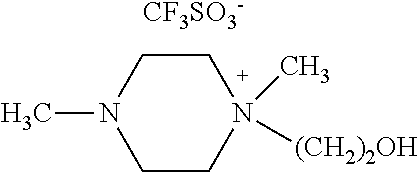
C00014

C00015
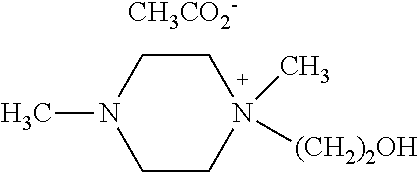
C00016
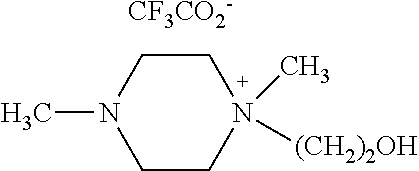
C00017
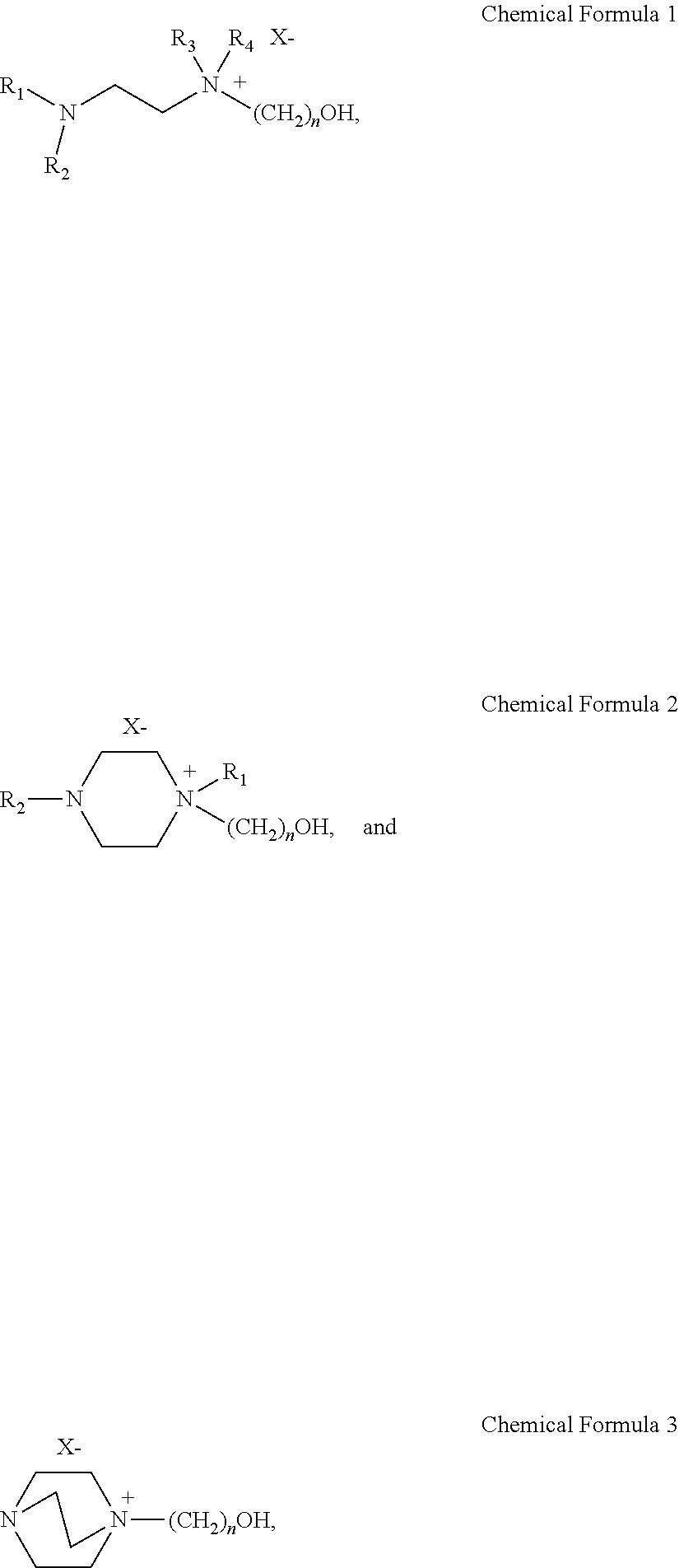
C00018
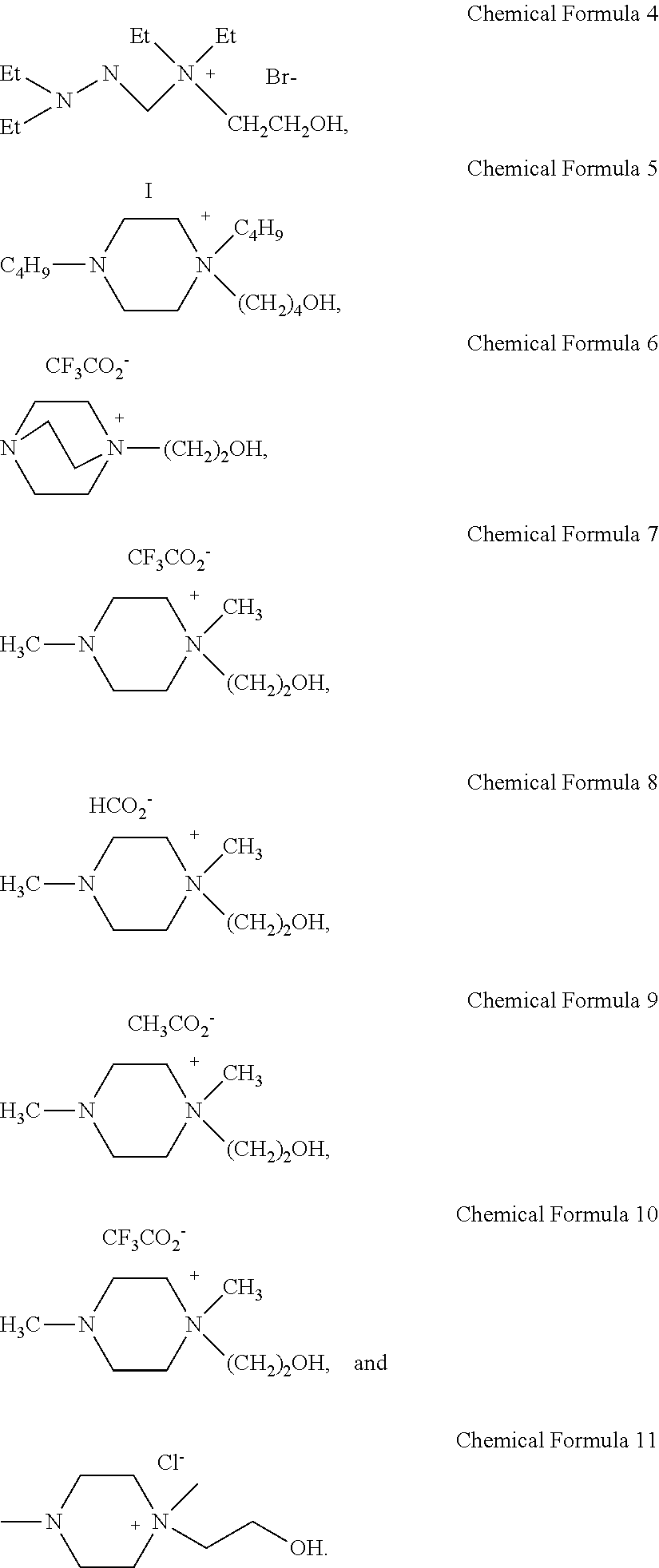
C00019
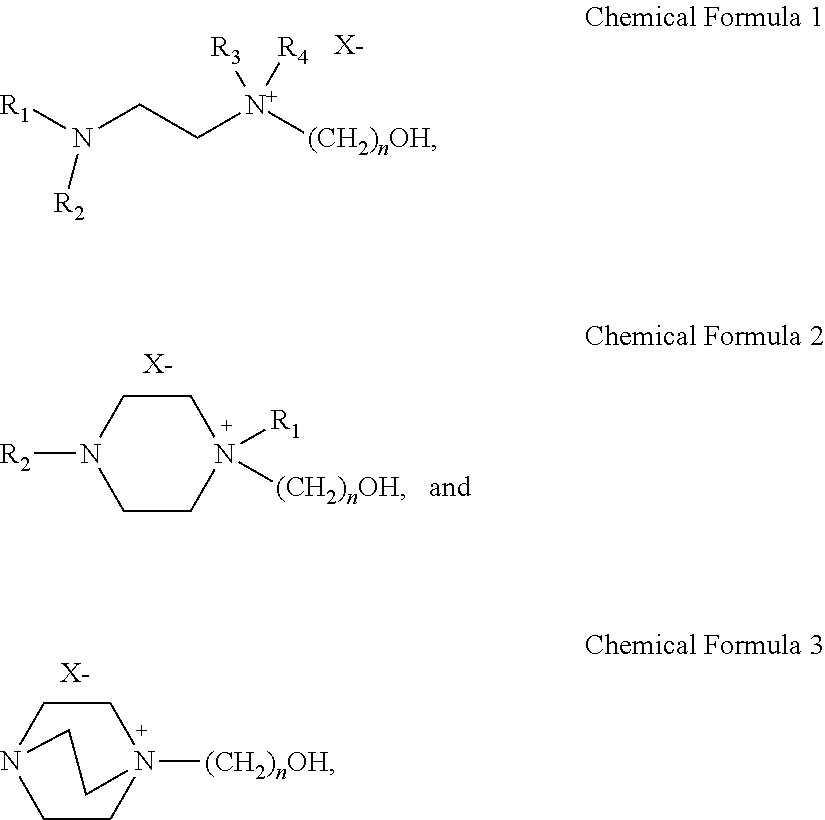
C00020

C00021

D00001
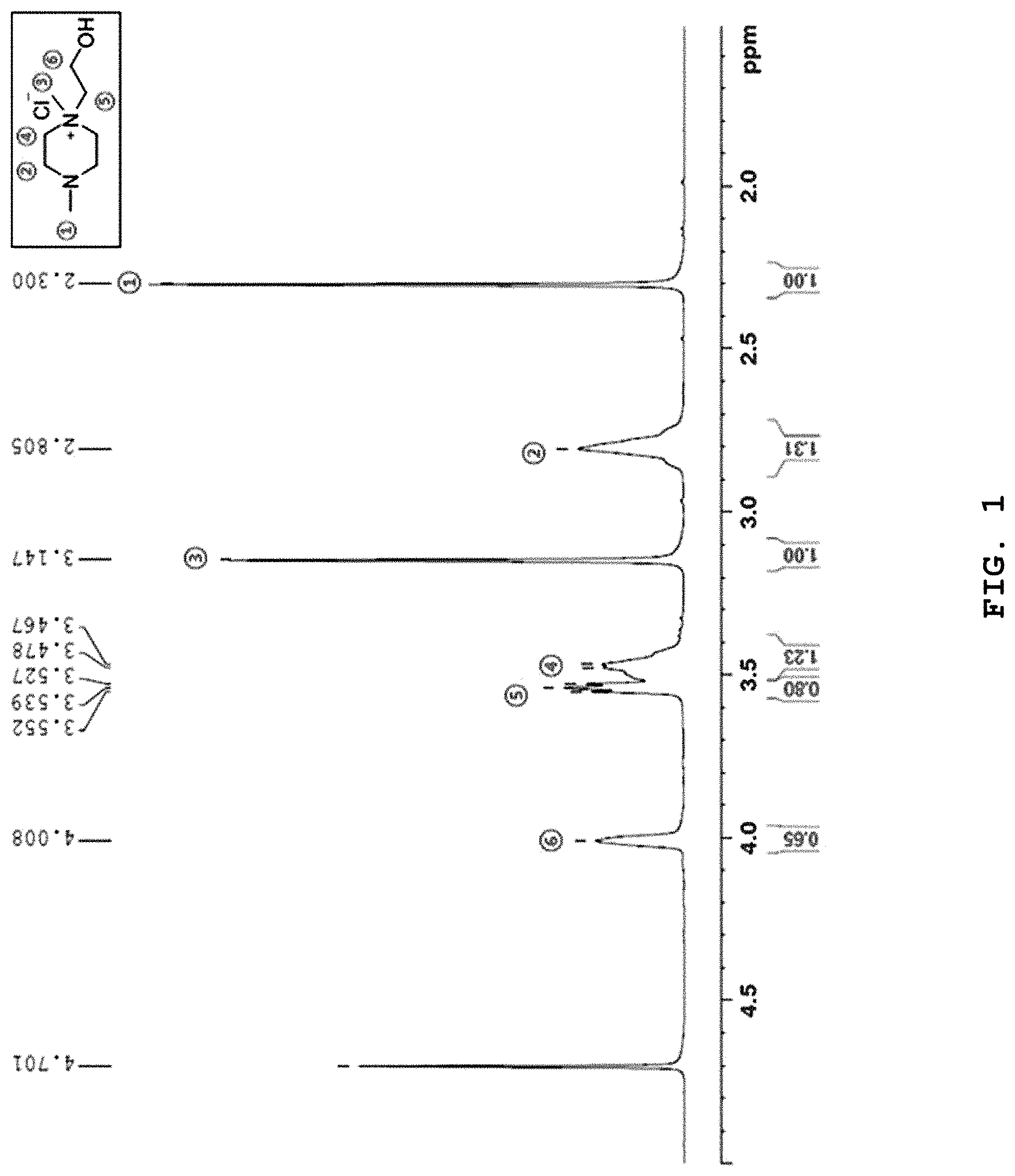
D00002
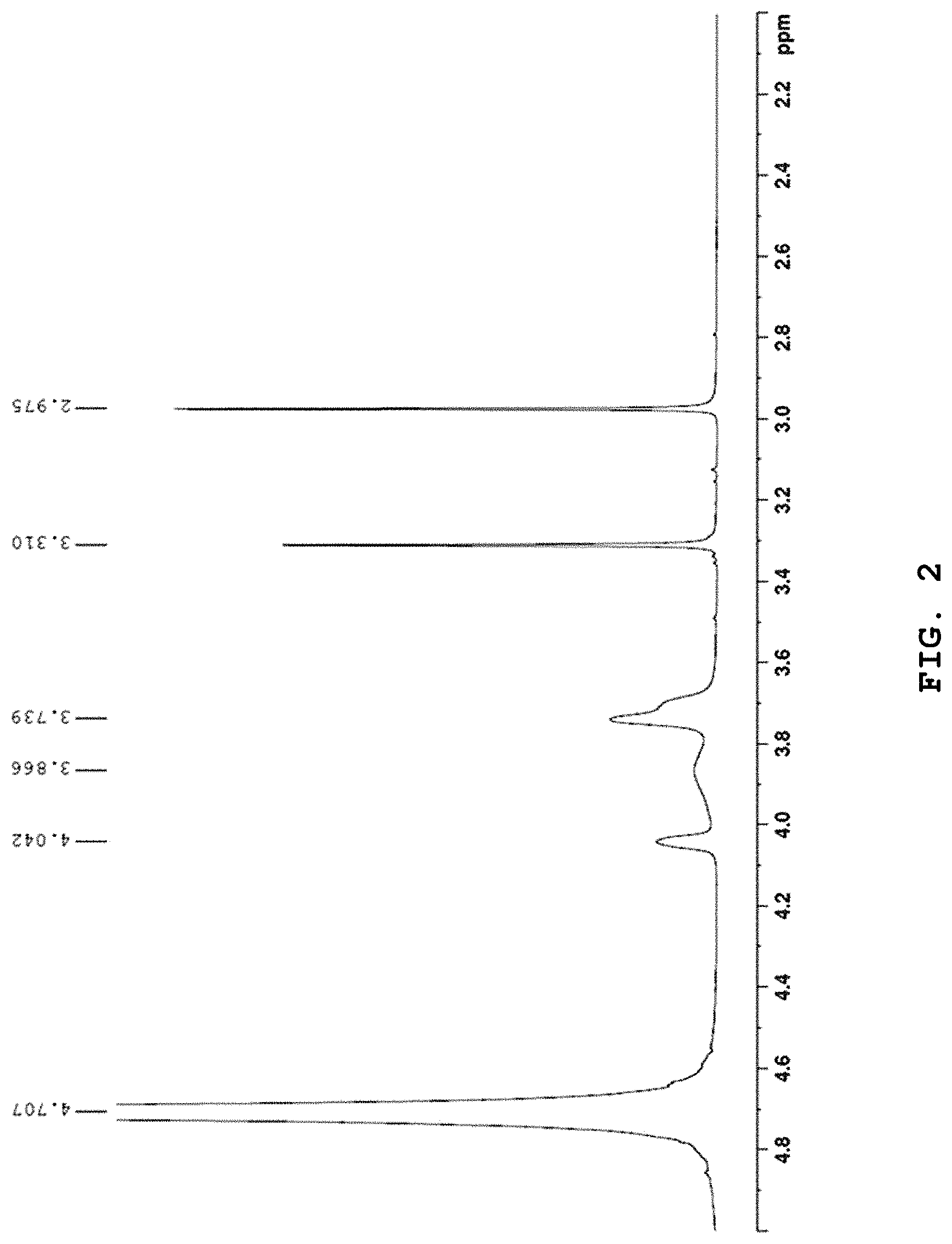
D00003

D00004

D00005
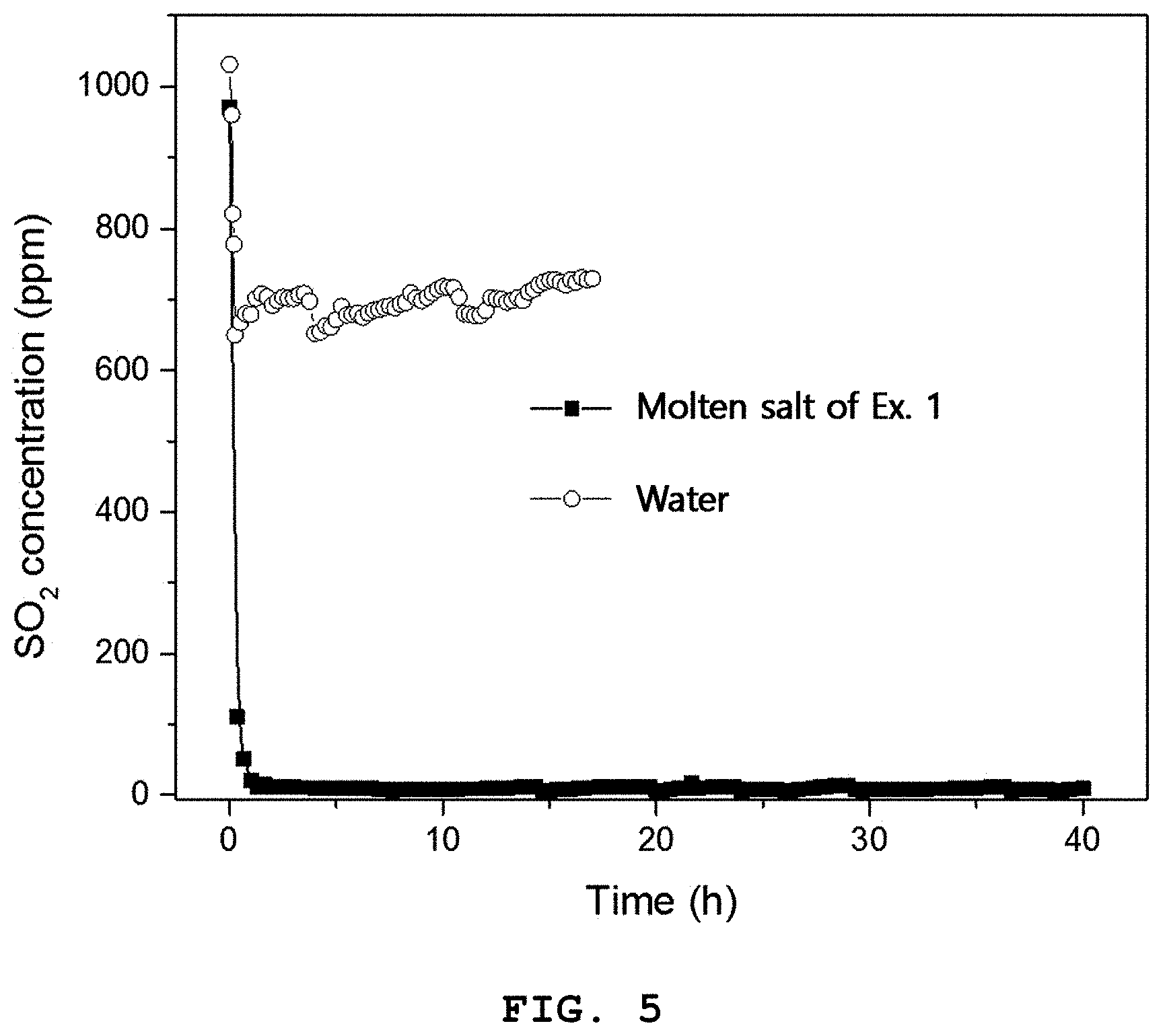
D00006
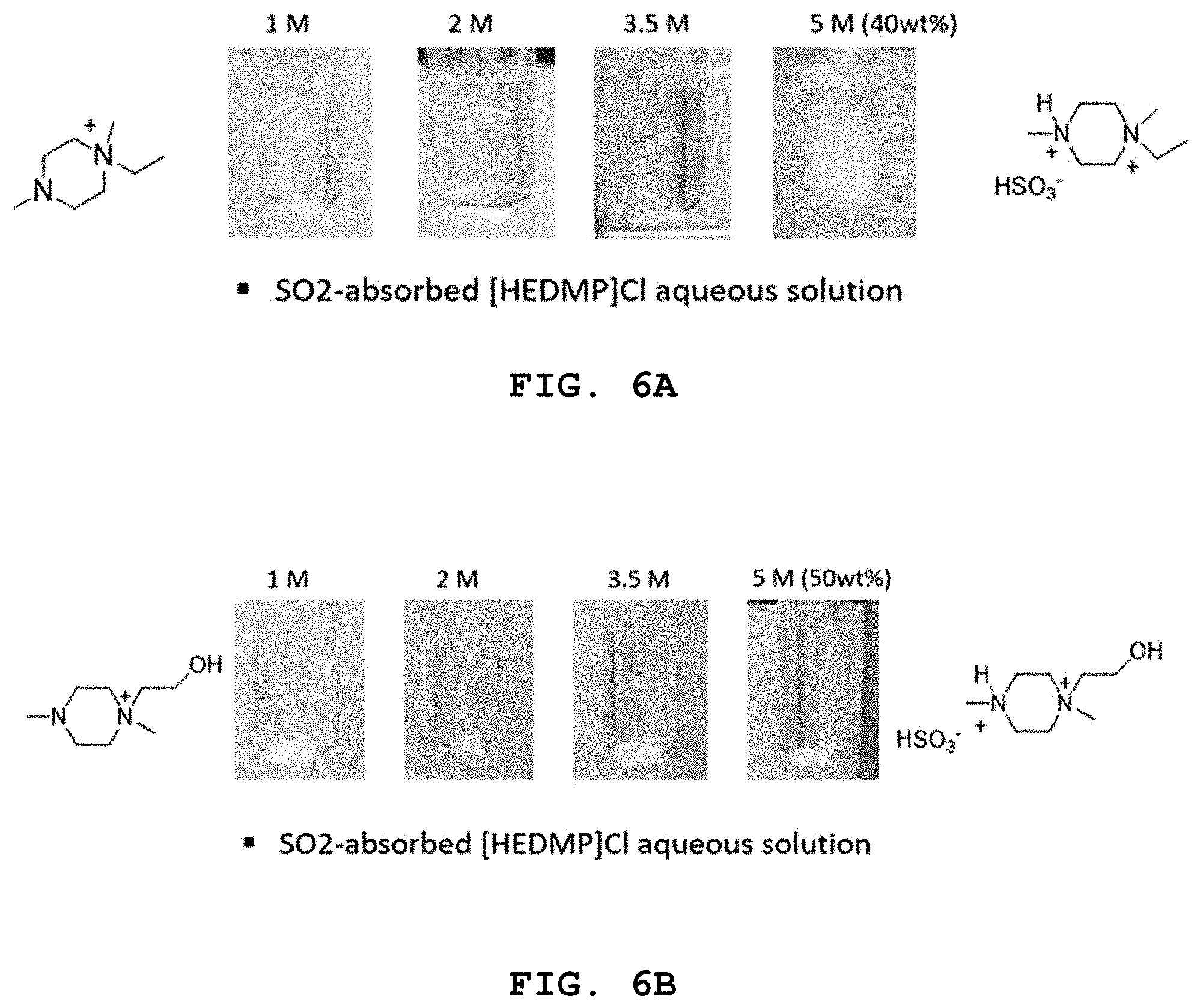
D00007

XML
uspto.report is an independent third-party trademark research tool that is not affiliated, endorsed, or sponsored by the United States Patent and Trademark Office (USPTO) or any other governmental organization. The information provided by uspto.report is based on publicly available data at the time of writing and is intended for informational purposes only.
While we strive to provide accurate and up-to-date information, we do not guarantee the accuracy, completeness, reliability, or suitability of the information displayed on this site. The use of this site is at your own risk. Any reliance you place on such information is therefore strictly at your own risk.
All official trademark data, including owner information, should be verified by visiting the official USPTO website at www.uspto.gov. This site is not intended to replace professional legal advice and should not be used as a substitute for consulting with a legal professional who is knowledgeable about trademark law.